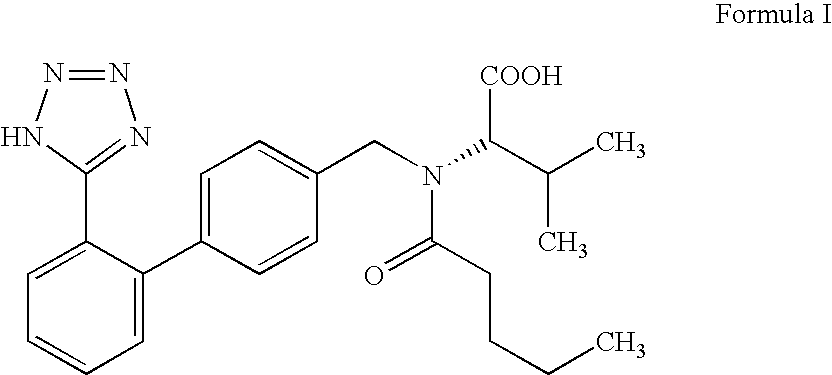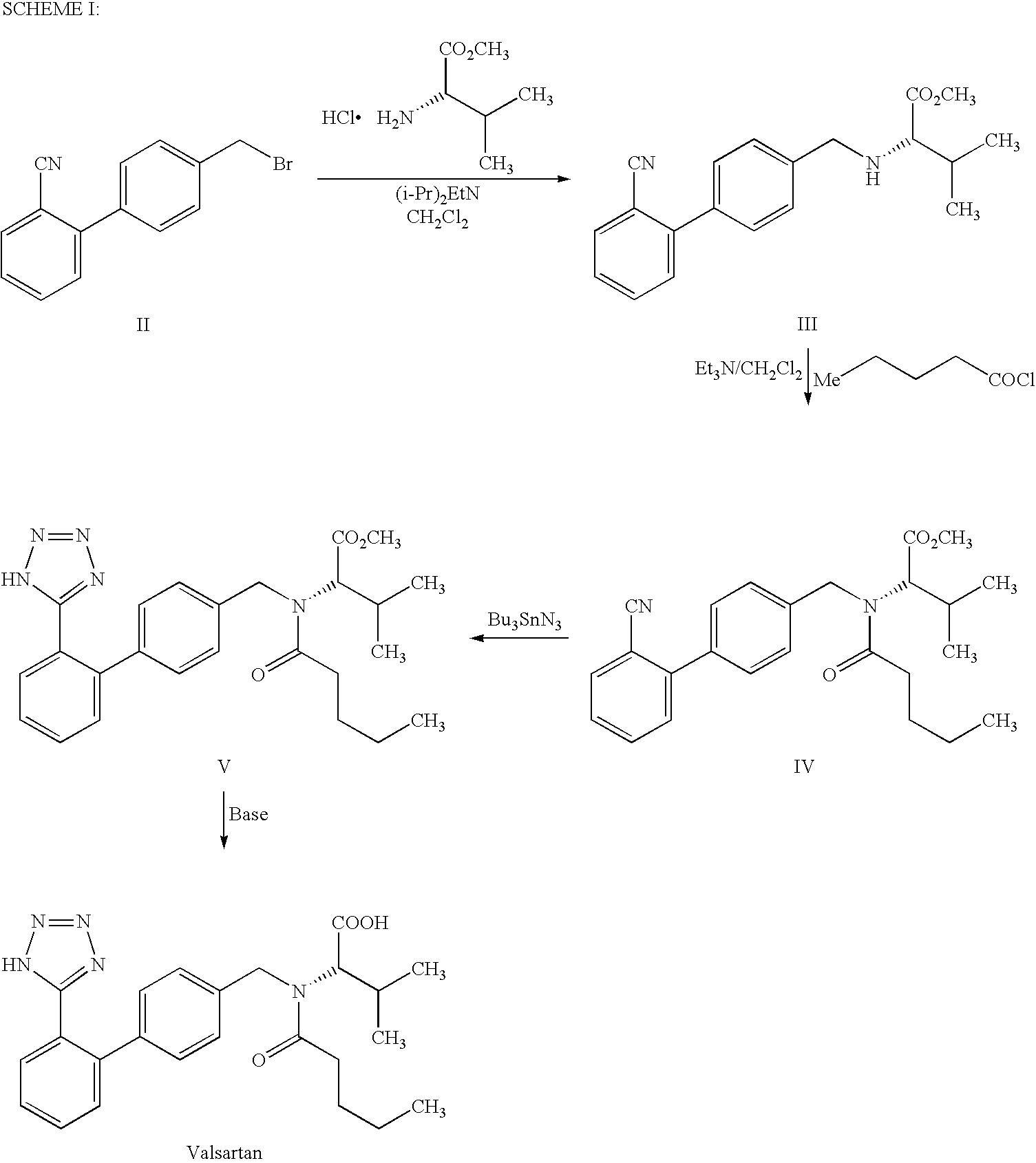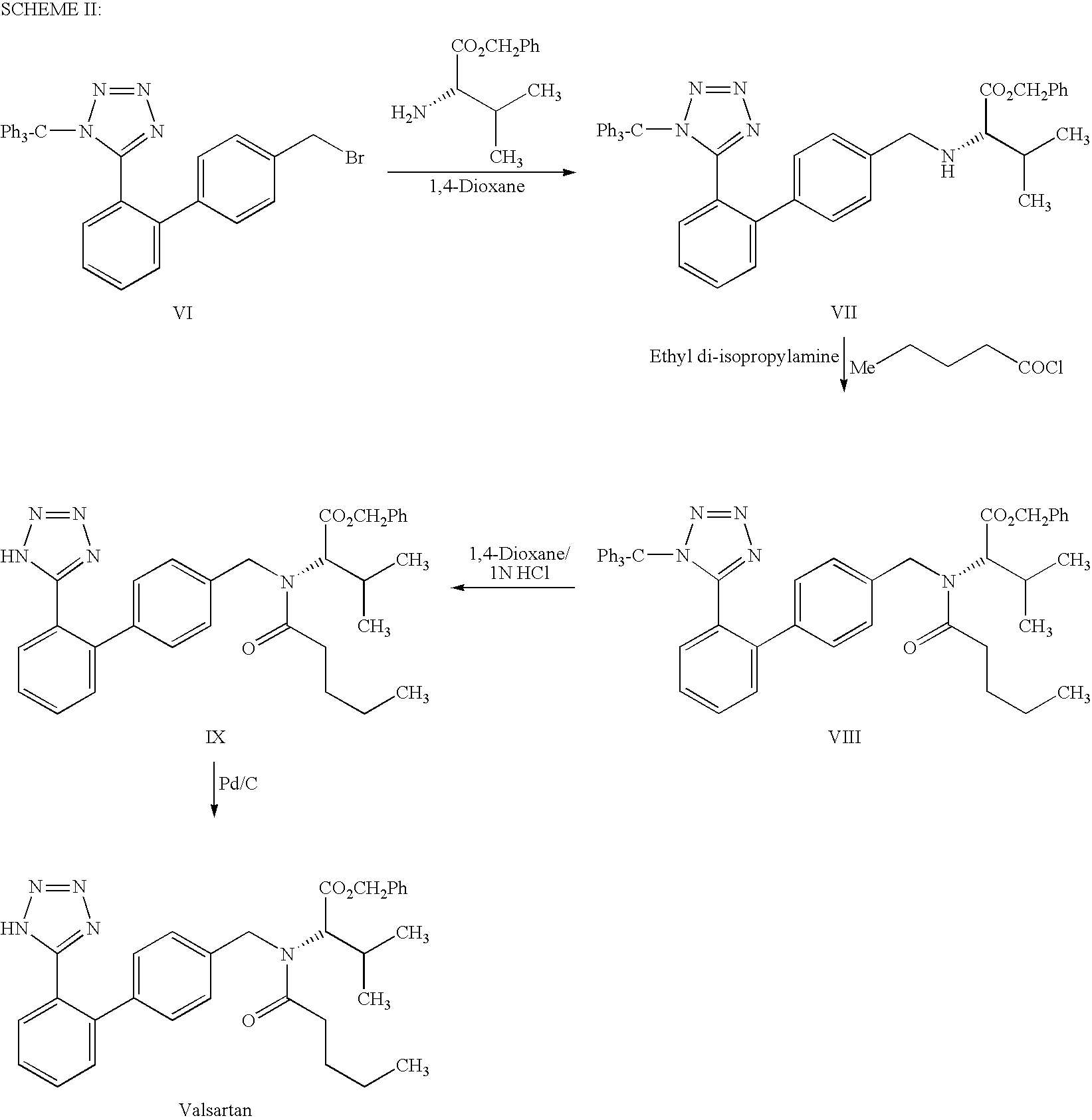Process for the preparation of angiotensin II antagonist
a technology of angiotensin and antagonist, applied in the field of process for the preparation of angiotensin ii antagonist, can solve the problems of high safety demands, use of toxic tributyl tin azide to build the tetrazol ring, and inability to crystalliz
- Summary
- Abstract
- Description
- Claims
- Application Information
AI Technical Summary
Benefits of technology
Problems solved by technology
Method used
Image
Examples
example i
Step A: Preparation of N-[[2′-(1-triphenylmethyltetrazol-5-yl)biphenyl-4-yl]methyl]L-valine methyl ester oxalate
[0030]L-Valinemethyl ester hydrochloride (132.2 g, 0.789 mole) was added to the mixture of 1-triphenylmethyl-5-[4′-(bromomethyl)biphenyl-2-yl]tetrazole (400 g, 0.717 mole) and N,N-dimethylformamide (400 ml) at 20-30° C. Diisopropylethylamine (231.7 g) was added to the reaction mass at 20-30° C. and heated to 45-50° C. The reaction mass was maintained for 16 h at 45-50° C. and concentrated under reduced pressure. The reaction mass was dissolved in ethyl acetate (800 ml) and washed successively with DM water (400 ml) followed by 10% w / w aqueous sodium chloride solution (200 ml) at 20-30° C. The organic layer was diluted with ethyl acetate (1200 ml) and treated with oxalic acid dihydrate (99.5 g, 0.789 mole) at 20-30° C. The reaction mixture was cooled to 0-5° C. and stirred for 1 h at 0-5° C. The solid product was filtered, washed with ethyl acetate and dried to yield N-[[2′...
example ii
Preparation of [N-(1-oxopentyl)-N-[[2′-(1H-tetrazol-5-yl)[1,1′-biphenyl]-4-yl]methyl]-L-valine] (Valsartan)
[0036]N-(1-Oxopentyl)-N-[[2′-(1H-tetrazol-5-yl)-[1,1′-biphenyl]-4-yl)methyl]-L-valine methyl ester (45 g) produced as per step (C) of Example I was reacted with 15% w / v aqueous barium hydroxide solution (528 ml) for 10 h at 20-30° C. After completion of reaction, the precipitated solid was filtered, treated with 10% w / v dilute HCl to pH 0.5 to 1.5 in DM water and isolated crude Valsartan.
[0037]The crude Valsartan was dissolved in 2.5% w / v aqueous sodium carbonate solution (460 ml) at 20° C.-30° C. and pH was adjusted to 5-7 with 10% w / v hydrochloric acid and then washed with methylene chloride (90 ml). The aqueous layer was acidified with 10% w / v hydrochloric acid and the product was extracted with ethyl acetate (495 ml). The organic layer was separated and ethyl acetate was distilled completely under reduced pressure at 20-60° C. The resulting solid mass was dissolved in ethyl...
PUM
| Property | Measurement | Unit |
|---|---|---|
| temperature | aaaaa | aaaaa |
| temperature | aaaaa | aaaaa |
| purity | aaaaa | aaaaa |
Abstract
Description
Claims
Application Information
 Login to View More
Login to View More - R&D
- Intellectual Property
- Life Sciences
- Materials
- Tech Scout
- Unparalleled Data Quality
- Higher Quality Content
- 60% Fewer Hallucinations
Browse by: Latest US Patents, China's latest patents, Technical Efficacy Thesaurus, Application Domain, Technology Topic, Popular Technical Reports.
© 2025 PatSnap. All rights reserved.Legal|Privacy policy|Modern Slavery Act Transparency Statement|Sitemap|About US| Contact US: help@patsnap.com



